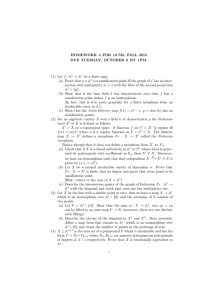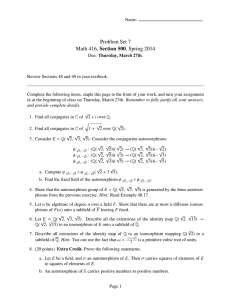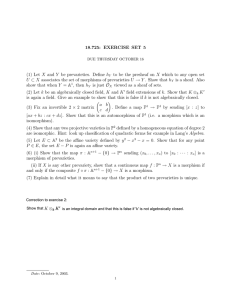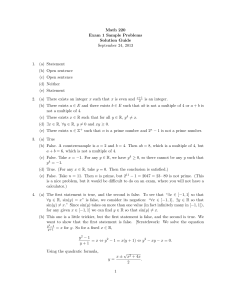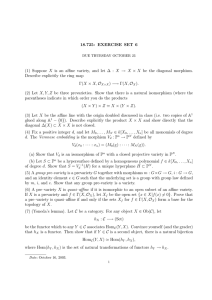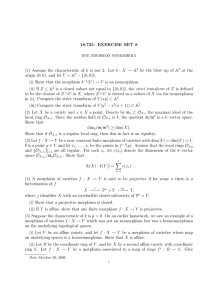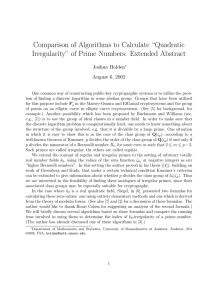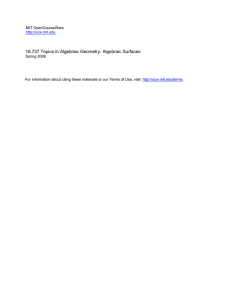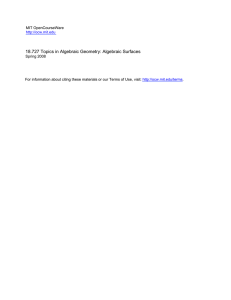Fields and Galois Theory, Math 422-501 January 2015 Homework 2
advertisement
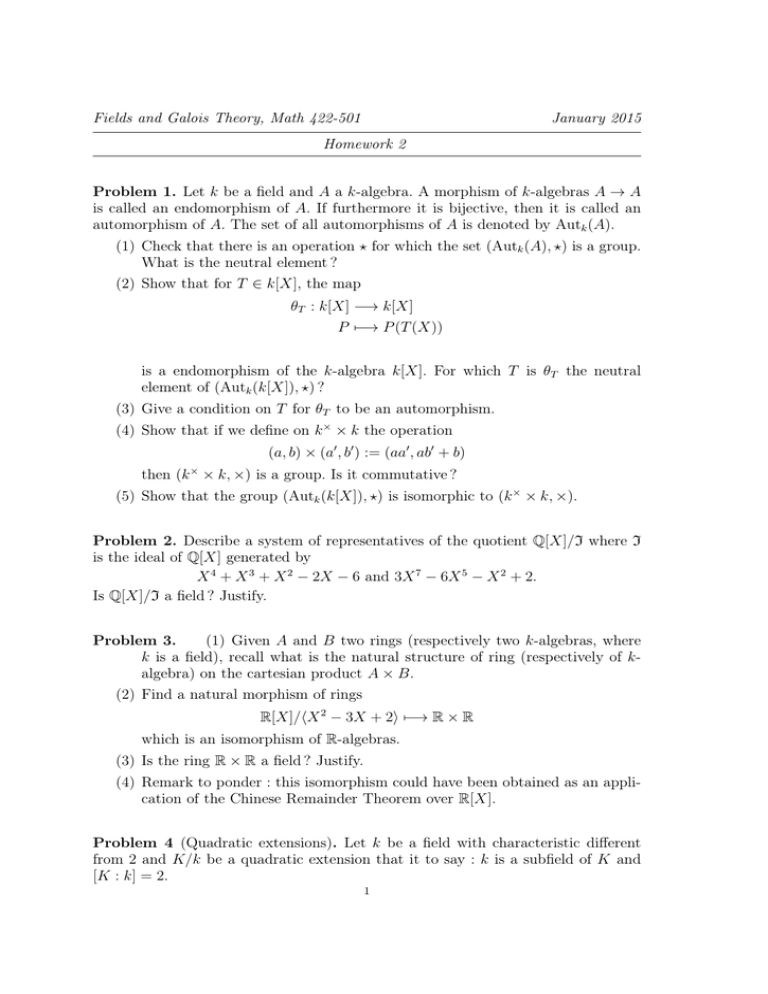
Fields and Galois Theory, Math 422-501
January 2015
Homework 2
Problem 1. Let k be a field and A a k-algebra. A morphism of k-algebras A → A
is called an endomorphism of A. If furthermore it is bijective, then it is called an
automorphism of A. The set of all automorphisms of A is denoted by Autk (A).
(1) Check that there is an operation ? for which the set (Autk (A), ?) is a group.
What is the neutral element ?
(2) Show that for T ∈ k[X], the map
θT : k[X] −→ k[X]
P 7−→ P (T (X))
is a endomorphism of the k-algebra k[X]. For which T is θT the neutral
element of (Autk (k[X]), ?) ?
(3) Give a condition on T for θT to be an automorphism.
(4) Show that if we define on k × × k the operation
(a, b) × (a0 , b0 ) := (aa0 , ab0 + b)
then (k × × k, ×) is a group. Is it commutative ?
(5) Show that the group (Autk (k[X]), ?) is isomorphic to (k × × k, ×).
Problem 2. Describe a system of representatives of the quotient Q[X]/I where I
is the ideal of Q[X] generated by
X 4 + X 3 + X 2 − 2X − 6 and 3X 7 − 6X 5 − X 2 + 2.
Is Q[X]/I a field ? Justify.
Problem 3.
(1) Given A and B two rings (respectively two k-algebras, where
k is a field), recall what is the natural structure of ring (respectively of kalgebra) on the cartesian product A × B.
(2) Find a natural morphism of rings
R[X]/hX 2 − 3X + 2i 7−→ R × R
which is an isomorphism of R-algebras.
(3) Is the ring R × R a field ? Justify.
(4) Remark to ponder : this isomorphism could have been obtained as an application of the Chinese Remainder Theorem over R[X].
Problem 4 (Quadratic extensions). Let k be a field with characteristic different
from 2 and K/k be a quadratic extension that it to say : k is a subfield of K and
[K : k] = 2.
1
2
(1) Show that there is x ∈ K − k such that x2 ∈ k × and K = k(x).
Hint : check that there is a basis of K as a k-vector space of the form {1, z}.
Express z 2 using 1 and z and find x...
(2) Check that any other element y ∈ K − k satisfying y 2 ∈ k × can be written
y = λx for λ ∈ k.
√
(3) Let Q ⊂ k√⊂ C and suppose that k/Q is quadratic. Show that k = Q[ n]
or k = Q[i n] where n ∈ N − {0, 1} has no square factor (that is to say n is
a product of distinct prime numbers).
√
√
Problem 5. Let α = 3 + 5. Denote by Q[α] the sub-Q-algebra of R generated
by α.
√ √
√
√
(1) Let Q[ 3, 5] √
be the
√ sub-Q-algebra of R generated by 3 and 5. Show
that Q[α] = Q[ 3, 5].
√
√
(2) Prove that α = 3 + 5 is algebraic (over Q), give its minimal polynomial
Π and its degree.
1
(3) Give an expression of
as a linear combination of 1, α, α2 and α3 with
1+α
rational coefficients.
(You can proceed by first finding the greatest common divisor of Π and B =
X +1 and two polynomials U and W in Q[X] such that U Π+BV = 1. There
is also a more elementary method to solve this question.)
(4) What are the subfields of Q[α] ? You may use the result of Problem 4 (3).
Problem 6. We admit the following result known as Eisenstein Criterion.
Let f ∈ Q[X] a unitary polynomial with degree m ≥ 1
f = X m + am−1 X n−1 + · · · + a1 X + a0 .
Suppose that
(i) a0 , . . . , am−1 ∈ Z,
(ii) there is a prime number p that divides a0 , . . . , am−1 and
(iii) p2 does not divide a0 .
Then f is irreducible over Q.
—————————————————————————————————————
Let p be a prime number. Consider Φp = X p−1 + X p−2 + · · · + X + 1.
(1) Apply the criterion to Φp (X + 1) and show that Φp is irreducible over Q.
(2) What is the degree d of xp := e2iπ/p over Q ?
(3) Let ap := cos(2π/p).
(a) Show that Q[ap ] is a subfield of Q[xp ].
(b) Show that xp is algebraic with degree 2 over Q[ap ].
(c) What is the degree of cos(2π/p) over Q ?
